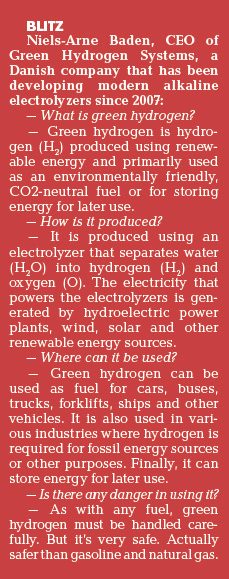New Technologies
Green hydrogen in the world and Kazakhstan
In addition to natural gas and solar and wind energy, hydrogen will become one of the key fuel resources in the future. According to analysts, its demand in the next 20-30 years will grow as the world economy transitions to low-carbon development.

In the zero carbon footprint scenario prepared by BP, it is predicted that global H2 consumption will amount to 16% of the global energy balance, with its share reaching 18% in industry and 10% in the transport sector. The global Hydrogen Council initiative has similar forecasts, which expects that by 2050 hydrogen will take up 18% of final consumption, forming a market with a capacity of 2.5 tln USD.
At the current cost of production, the leading producers of hydrogen are gas producers (the so-called blue hydrogen), generating it by steam conversion of methane, but BP expects that by 2050, up to half of the production of this type of fuel can be formed by green hydrogen produced by electrolysis from electricity generated by renewable energy sources.
The developed countries of the world are actively moving towards a hydrogen future. The European Union has announced its intention to support the construction of renewable energy electrolyzers with a capacity of at least six GW by 2024, which will ensure the production of 1 mln tons of green hydrogen.
Germany
In June 2020, the German Government approved a National Hydrogen Strategy worth nine bln euros. Its main task is to combine the further industrial development of the country and the protection of the global climate. The tactical goal is to fulfil the commitments to reduce greenhouse gas emissions into the atmosphere by 2030 and 2050, undertaken by Germany and the European Union under the Paris Climate Agreement.
The document contains 38 political, legislative, tax and financial measures to ensure a large-scale plan to support environmentally friendly hydrogen technologies in various fields – not only in the electric power industry, road and rail transport but also in ferrous metallurgy, petrochemistry, aviation.
This year, Germany has taken a new step towards its declared goal of becoming one of the world leaders in the hydrogen economy. According to Deutsche Welle, the Government has allocated 290 mln euros to create and finance four innovation and technology centres (ITZ) until 2024, which will develop hydrogen technologies for the transport sector – cars and trucks, trains, river and sea vessels, aircraft. "These centres will take into account different needs of the industry and focus on different tasks," Andreas Scheuer, Minister of Transport and Digital Infrastructure of Germany explained in an interview with the publication.
To combine both innovation and regional policy tasks, the Ministry decided to distribute budget funds between Western, Eastern, Northern and Southern Germany, directing funds mainly to medium-sized and even small cities.
Thus, one of the four centres, the southern one, will be located in the town of Pfaffenhausen, which has only about five thousand inhabitants. But it is here that the lion's share of the allocated funds will be directed – up to 100 mln euros. The main specialization of this innovation and technology centre will be the development of hydrogen solutions for passenger cars, trucks and buses. Moreover, it is less than 100 kilometres from here to Munich, where the headquarters and head factories of the BMW carmaker and the truck and bus manufacturer MAN are located. Both companies are actively switching to electric vehicles now, but they do not exclude the production of hydrogen-powered cars. Another specialization of the Bavarian centre, the Ministry points out, will be the creation of components and technologies for aircraft construction, including for light aircraft. After all, the aerospace industry is booming in Bavaria right now.
In the west of Germany, the new centre will be located in Duisburg. The largest river port in Europe is located in this city on the Rhine with a population of half a million, so one of the areas of scientific and design work will be the maintenance of shipping and, possibly, shipbuilding. But they will also be engaged in the search for technological solutions for rail and road freight transportation.
In the east of the country, in the federal state of Saxony on the territory of the former GDR, the hydrogen innovation and technology centre will be located in Chemnitz next to the Technical University (TU Chemnitz) and two institutes of applied research of the Fraunhofer Society (Fraunhofer Gesellschaft), one of which, for example, work in the field of machine tool construction. The specialization of the Saxon Center will be, in particular, railway transport – locomotives and trams, as well as trucks, construction and agricultural machinery.
The fourth, the northern centre, will rather become a cluster since it will be located not in one but three points at once – Hamburg, Bremen/Bremerhaven and Stade. It is quite natural that in these port cities on the shores of the North Sea, one of the main areas of upcoming research will be maritime navigation.
However, enterprises of the German aerospace industry, owned, in particular, by the European Airbus, are also concentrated in this region. Therefore, another specialization of the northern cluster will be aircraft construction. In addition, in this region back in 2018, two hydrogen trains began to be tested for the first time in the world, after which the regional railway company ordered 14 such trains, which will start arriving at the end of 2022. Now on the agenda is the use of H2 for freight rail transport.



